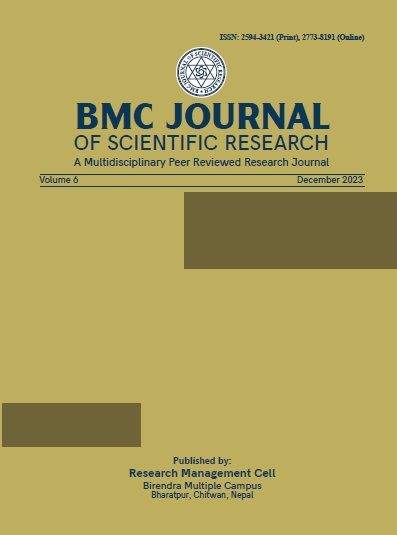ARIMA and Exponential Smoothing Model to Forecast Average Annual Precipitation in Bharatpur, Nepal
DOI:
https://doi.org/10.3126/bmcjsr.v6i1.60959Keywords:
ARIMA, exponential smoothing, precipitation, prectotcorr, rainfall forecastingAbstract
Precipitation includes different kinds of moisture that fall from the sky to the Earth's surface, like rain, snow, sleet, hail, or drizzle. In places with flat terrain like Bharatpur, rainfall is the predominant form of precipitation. Therefore, in the plains of Nepal, most of the precipitation comes in the form of rainfall. Rainfall is a natural occurrence known for its unpredictable nature, making it difficult to predict accurately. However, there are statistical methods that can help forecast future rainfall using past data. This research focuses on developing a reliable forecasting model: Auto Regressive Integrated Moving Average and Exponential Smoothing for the prediction of average annual precipitation in Bharatpur, Nepal. The primary objectives are to develop, compare, and identify the superior model between these two approaches. Utilizing average annual adjusted precipitation data (PRECTOTCORR) obtained from the National Aeronautics and Space Administration website for the period 1990 to 2021, both the models were trained and validated using distinct training and test sets. The comparison of these models is based on the minimum Mean Squared Error criterion. The findings reveal that the ARIMA (1, 2, 1) model effectively predicts average annual precipitation in Bharatpur for future periods, outperforming the Exponential Smoothing Model. The results indicate that the time series model for the studied area differs from those of previously examined regions, highlighting the need for a model tailored to the specific characteristics of this region. The research provides valuable insights for stakeholders involved in water management and agricultural planning within the region. Accurate rainfall predictions, as demonstrated by the superior performance of the ARIMA model, can empower decision-making processes related to water resource management and agricultural planning. This, in turn, has the potential to enhance productivity and sustainability outcomes.
Downloads
Downloads
Published
How to Cite
Issue
Section
License
Copyright (c) 2023 Research Management Cell, Birendra Multiple Campus

This work is licensed under a Creative Commons Attribution-NonCommercial-ShareAlike 4.0 International License.




